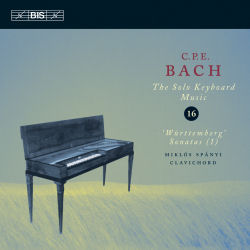|
 CPE Bach - The Solo Keyboard Music Volume 16 ‘Württemburg’ Sonatas (1) CPE Bach - The Solo Keyboard Music Volume 16 ‘Württemburg’ Sonatas (1)
Sonata No. 1 in A minor, Wq 49/1 (H 30)
Sonata No. 2 in A flat major, Wq 49/2 (H 31)
Sonata No. 3 in E minor, Wq 49/3 (H 33)
Miklós Spányi - Clavichord
BIS-CD-1423 [rec.2003, released 2007]
This is a fantastic CD. In particular I admire Spányi’s fluid ornamentation and rubato, creating expressive contours that enhance the drama of the music. The recording quality is also very good, although obviously not as good as being there, seeing it live. The sound is pleasant, nice, but the bass seemed to have been enhanced with reverb (tastefully), resulting in a quasi-transcription of clavichord sound for CD. This happens in all recordings to some extent, yet seems to change the ambience particularly with the clavichord.
The CD has certainly done its job in that I feel a burning ambition to see Spányi perform live. One of my favourite moments occurs 50 seconds into the first movement of the Sonata No.2 in A flat major, Wq 49/2 (H 31), where Spányi creates an exquisite affetuoso effect that in many ways exactly captures the essence of CPE Bach’s style - a sudden, totally unexpected moment of tenderness in direct contrast to the material that it surrounds. The Sonata No.1 in A minor, Wq 49/1 (H30), brings Spányi’s artistic virtuosity to the fore, with each movement given the clearly defined and contrasting emotional character that it demands. The Sonata No.3 in E minor, Wq/3 (H 33), is impressively "orchestrated" by Spányi, the opening recalling the French Overture style of CPE’s father.
Aleks Szram
Note:
It was hard to write this CD review for two reasons: firstly, the music is by CPE Bach, and secondly, it is performed on the clavichord. If I were writing for the British Clavichord Society, or for the American Bach Society for instance, at least one of these problems would be removed, as I would be aware of who I was communicating to, and thus what information I should or should not include. As it is, most people, even those who are big fans of ‘classical music’, rarely venture near either CPE Bach or the clavichord. It is a great pity.
So for those who already know all about CPE and the Clavichord, please ignore the next few paragraphs.
Carl Philipp Emanuel Bach (1714-1788), son of JS, composed some of the most exciting and passionate music I have ever discovered. To A-Level music students he’s often presented as a cross-over composer, sandwiched between the Baroque and Classical eras, which is an insulting oversimplification of his style. I’ve always thought of him in connection to Sturm und Drang, his music exhibiting savage contrasts of mood and character that were later to profoundly influence Beethoven. Why is his music so seldom performed on the piano? For a start, many teachers have no idea how to interpret it, and thus shy away, while there can be difficulties grasping the stylistic challenges and interpreting the ornamentation. How savage should the dynamics be? How should we approach pedalling? Should we ‘transcribe’ for the modern piano, or restrain the dynamic possibilities of the instrument? We seem to have reached a modern consensus for Mozart , yet for CPE Bach these matters are still open to debate. (My feelings are that CPE Bach would have LOVED the modern piano.)
And for the listener? Who knows. I have always been captivated by the music. I can only suggest reasons... the music is often structurally challenging, as Haydn can be, and the sudden emotional contrasts could possibly be seen as unsettling; it could never go on the Hi-Fi as dinner-party background music.
Nevertheless, I recommend that everyone should listen to it!!!
Now to the clavichord - for a more detailed explanation see Wikipedia et al - suffice to say that it is an early keyboard instrument with tangents that touch the string, instead of hammers that strike the string (as with the piano.) The most exciting thing about the clavichord is that the player can produce vibrato, by subtly moving the tangent while it is in contact with the string. So forget all those stories about Rachmaninov playing the piano with vibrato, this is the real deal! For this reason, I consider the clavichord to be the best keyboard instrument in town when judged as a vehicle for personal expression. Only on the clavichord are keyboardists able to shape the individual tones of a melody, as opposed to being limited to its general contour.
The main factor in the evolution of all instruments has been the quest for greater and greater volume. The clavichord cannot compete here - the perfect clavichord recital would be in a drawing room, to an audience of 5-10 people. As you can imagine, this is not much use to either the concert promoter or to the budding keyboardist hoping to make as much money as possible. You can forget those concerto appearances and duets with the Tuba too. But if you want to create a spellbinding, evocative, and above all personal effect on your audience - you can’t beat the clavichord.
Another thing that deserves to be mentioned, is that until recently it has proved very problematic to record the clavichord. The tangent making contact with the string makes a percussive sound that is nearly as loud as the resulting tone, and very attractive to the microphone. Thankfully this problem has recently been greatly surmounted.
|

